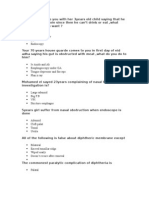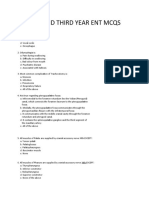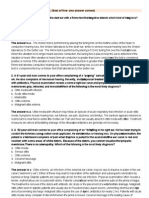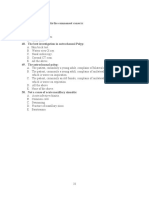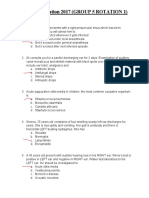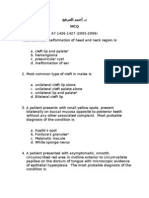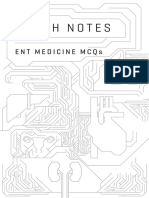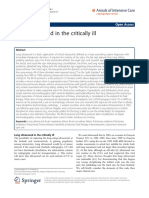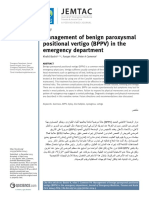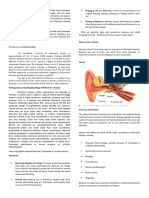ENT
ENT
Uploaded by
Nikita NanwaniOriginal Description:
Copyright
Available Formats
Share this document
Did you find this document useful?
Is this content inappropriate?
Report this DocumentCopyright:
Available Formats
ENT
ENT
Uploaded by
Nikita NanwaniCopyright:
Available Formats
SELF ASSESSMENT
&
REVIEW OF FMGE/MCI SCREENING EXAMINATION
EAR, NOSE AND THROAT (ENT) (Questions)
EAR
1. Hyperacusis is seen in all of the following except: a. Exposure to loud sounds b. Otosclerosis c. Meniere's disease d. Severe head injury 2. Menieres disease is characterized by the triad of a. Deafness, nystagmus, tremors b. Deafness, vertigo, nystagmus c. Deafness, tinnitus, vertigo d. Deafness, tremors, tinnitus 3. The first clinical presentation of acoustic neuroma is feature of: a. Brainstem involvement b. Cerebellar involvement c. Facial nerve involvement d. Cochleovestibular symptoms 4. Most common cause of conductive deafness in children less than 12yrs: a. CSOM b. Otosclerosis c. Serous otitis media d. Atresia of auditory canals on both sides 5. Negative Rhinne's test for 256 Hz tuning fork indicates a minimum air-bone gap of a. lOdB b. 15dB c. 20dB d. 25dB 6. Cauliflower ear seen in: a. Hematoma of the auricle b. Carcinoma of the auricle c. Fungal infection of the auricle d. Congenital deformity 7. Causative organism for malignant otitis externa is: a. Hemophilus b. Staphylococcus c. Streptococcus d. Pseudomonas 8. Unilateral conductive hearing loss in a patient with history of head injury. On examination, tympanic membrane is normal and mobile. The cause for deafness could be: a. Collection of fluid in the middle ear b. Otosclerosis c. Dislocation of the incudostapedial joint d. ASOM 9. Most common cause of chronic ear infection in India is: a. Syphilitic otitis media b. TB otitis media c. CSOM d. Fungal otitis media 10. Referred pain in the ear is commonly from: a. Maxillary carcinoma b. Nasopharyngeal carcinoma c. Carcinoma tongue d. Malignant otitis externa 11. Tuning fork frequency used for testing is: a. 512 Hz b. 1048 Hz c. 248 Hz d. All of the above 12. Calorie test based on thermal stimulation of which part of the semi circular canals: a. Lateral b. Posterior c. Anterior d. All of the above 13. All of the following are true about glomus-jugulare tumor except: a. Commonly metastasizes to lymph nodes b. Pulsatile tinnitus and conductive deafness seen c. Most commonly affects male d. Paraganglioma's 14. Malignant otitis externa is caused by: a. S.aureus b. S. albus c. P. aeruginosa d. E. coli 15. The limit of loudness (expressed as decibels) that workers can tolerate without substantial damage to their hearing, during their work hours, is: a. 55 b. 65 c. 75 d. 85 16. Which is not seen in Meniere's disease a. Tinnitus b. Hearing loss c. Loss of consciousness d. Vertigo 17. Which of the following forms lateral wall of mastoid antrum: a. Mastoid process b. Suprameatal triangle c. Petrous temporal bone d. Tympnaic cleft 18. Bithermal caloric test stimulates which of the following: a. Superior semicircular canal b. Posterior semicircular canal c. Horizontal semicircular canal d. All of the above 19. Which of the following defines vertigo: a. Ringing of ears b. Subjective sense of imbalance c. Sense of pressure in the ear d. Infection of the inner ear
NOSE
20. CSF rhinorrhoea is due to the fracture of which of the following a. Nasal bones b. Cribriform plate c. Temporal bone d. Maxillary bone 21. Young's operation is done for: a. Atrophic rhinitis b. Vasomotor rhinitis c. Antrachonal polyp d. Allergic rhinitis
22. Treatment of choice for antrochoanal polyp: a. Intranasal polypectomy b. Caldwell-Luc operation c. Endoscopic sinus surgery d. Intranasal ethmoidectomy 23. Which of the following is associated with olfactory nerve dysfunction: a. Down syndrome b. Turner syndrome c. Parkinson disease d. Marfan syndrome 24. Sinus not present at birth is/are: a. Maxillary b. Ethmoidal c. Frontal d. All of the above 25. What is rhinophyma: a. Hypertrophy of sweat glands b. Hypertrophy of sebaceous glands c. Hypertrophy of meibomian glands d. Hypertrophy of lacrimal gland 26. Nasal angiofibroma of nose is common in: a. Younger males b. Younger females c. Young adults d. Adolescents of both sexes 27. Malignant tumour is commonest in which of the following sinus: a. Maxillary b. Frontal c. Ethmoidal d. Sphenoidal 28. A child presents with unilateral, foul smelling nasal discharge. Most probable cause could be: a. Acute sinusitis b. Foreign body c. Rhinolith d. Nasal synechiae
29. Sinus opening in middle meatus is: a. Posterior ethmoid sinus b. Sphenoid sinus c. Frontal sinus d. Nasolacrimal duct
THROAT
30. All of the following are true regarding tracheostomy tube except: a. Double lumen tube b. Made of titanium silver alloy c. Cuffed tube prevents aspiration of pharyngeal secretions d. Ideally should be changed every 3rd day 31. One of the most important complication of tracheostomy is: a. Surgical emphysema b. Hemorrhage c. Recurrent laryngeal nerve palsy d. Displacement of tube 32. Stridor in an infant is most commonly due to: a. Diphtheria b. Acute epiglottitis c. Foreign body aspiration d. Laryngomalacia
MISCELLANEOUS
33. Paralysis of which muscle lead to hyperacusis in Bell's palsy: a. Tensor veli palatini b. Levator palatini c. Stapedius d. Sternocleidomastoid 34. Horner's syndrome is caused by: a. Facial injury b. Nasopharyngeal carcinoma with metastasis c. Meniere's disease d. All of the above
You might also like
- Neuroanatomy MCQDocument30 pagesNeuroanatomy MCQNishanthy Pirabakar90% (61)
- MCQsin ENTwith Explanations Module 2 OtologyDocument7 pagesMCQsin ENTwith Explanations Module 2 OtologyFatina AryanNo ratings yet
- Otorhinolaryngology SBA'sDocument22 pagesOtorhinolaryngology SBA'sJohn M. Hemsworth0% (1)
- Kidney MCQDocument14 pagesKidney MCQNikita Nanwani87% (38)
- Franco Matamala e Orero - Voice-over-Translation-an-Overview PDFDocument250 pagesFranco Matamala e Orero - Voice-over-Translation-an-Overview PDFJamille Pinheiro DiasNo ratings yet
- EAR MCQdoneDocument71 pagesEAR MCQdoneAbdur Raheem QureshiNo ratings yet
- امتحان ENT دفعة ٣١Document14 pagesامتحان ENT دفعة ٣١محمد عبد القاهر السروري100% (1)
- MCQZDocument55 pagesMCQZyasinoNo ratings yet
- ENT End-of-Posting Questions (30 Sep'05)Document6 pagesENT End-of-Posting Questions (30 Sep'05)John M. HemsworthNo ratings yet
- ENT Revision QuestionsDocument10 pagesENT Revision Questionsanas33% (3)
- ENT Paper 2Document13 pagesENT Paper 2John M. Hemsworth100% (1)
- MCQ 4 ENTDocument6 pagesMCQ 4 ENTapi-2618676650% (2)
- ENT Exam-TZAR DOHNS Report 2011-860056v1-UbayasiriDocument2 pagesENT Exam-TZAR DOHNS Report 2011-860056v1-Ubayasirinob2011nob0% (1)
- Ent MCQ A PFD PDFDocument61 pagesEnt MCQ A PFD PDFKay Bristol50% (2)
- Cerumen ImpactionDocument3 pagesCerumen ImpactionAira Alaro0% (1)
- Hearing LossDocument31 pagesHearing LossDat boi100% (1)
- MCQ ENT. DR NemerDocument7 pagesMCQ ENT. DR Nemeradham bani younesNo ratings yet
- Second and Third Year Ent McqsDocument6 pagesSecond and Third Year Ent Mcqsadham bani younesNo ratings yet
- ENT Practice MCQs With Key 4th Year MBBSDocument7 pagesENT Practice MCQs With Key 4th Year MBBSPatrick BatemanNo ratings yet
- OtologiDocument13 pagesOtologimr_curiousityNo ratings yet
- A. It Consists of Squamous EpitheliumDocument7 pagesA. It Consists of Squamous EpitheliumUzair KhanNo ratings yet
- ENT MCQ (Not Answered)Document75 pagesENT MCQ (Not Answered)mohamed mowafeyNo ratings yet
- Ent 25 ExamDocument8 pagesEnt 25 ExamAbd Alsalihi100% (1)
- 426 C1, ENT MCQsDocument10 pages426 C1, ENT MCQsSheikhaNo ratings yet
- MCQ in Orl CourseDocument46 pagesMCQ in Orl CoursesulnaikNo ratings yet
- Wa0000Document16 pagesWa0000hassan qureshi100% (1)
- Ent ExaminationDocument9 pagesEnt ExaminationSheikha100% (2)
- ENT MCQS (Ear, Pharynx, Tonsils, Deep Neck Infections, Oral Cavity)Document88 pagesENT MCQS (Ear, Pharynx, Tonsils, Deep Neck Infections, Oral Cavity)sidsudp75% (4)
- Aiims Adr Plexus EntDocument32 pagesAiims Adr Plexus Entkishorechandra75% (4)
- Ent Bcqs 3Document18 pagesEnt Bcqs 3Ghazi Uddin Ahmed0% (1)
- Questions ENT 2021Document28 pagesQuestions ENT 2021Ranjan Prasad100% (1)
- EennttDocument13 pagesEennttSuresh Kumar BansalNo ratings yet
- 1st Term ENTDocument9 pages1st Term ENThassan qureshi0% (1)
- ENT MCQforstudents AnswersDocument30 pagesENT MCQforstudents AnswersOlaNo ratings yet
- ENT MCQs Eiad NahlaDocument11 pagesENT MCQs Eiad Nahlaadham bani younesNo ratings yet
- ENT McqsDocument15 pagesENT McqsVitorLópezNo ratings yet
- I Am Sharing '100-mcq-complete-ENT' With YouDocument31 pagesI Am Sharing '100-mcq-complete-ENT' With Youhassan qureshi100% (1)
- Ent-Mcq-C2 426Document7 pagesEnt-Mcq-C2 426Sheikha100% (6)
- ENT Best Answer Select The One Best Answer:-: Omdurman Islamic University Medical Students AssociationDocument22 pagesENT Best Answer Select The One Best Answer:-: Omdurman Islamic University Medical Students AssociationAbd AlsalihiNo ratings yet
- MCQ Ent ThroatDocument16 pagesMCQ Ent ThroatDr-Firas Nayf Al-ThawabiaNo ratings yet
- (ENT-OPT-FRS) End-Posting Examination Questions (G5) - 20180208 - 175513Document23 pages(ENT-OPT-FRS) End-Posting Examination Questions (G5) - 20180208 - 175513Steph StephanieNo ratings yet
- Ent MCQDocument2 pagesEnt MCQtariq_siddiqui_11100% (1)
- MCQ It Blok 19 2006Document15 pagesMCQ It Blok 19 2006Anonymous XuDFuevOxNo ratings yet
- 3 RfajDocument81 pages3 RfajSheikhaNo ratings yet
- MCQ ENT 2Document3 pagesMCQ ENT 2api-26186766100% (1)
- Soal Bailey OtologiDocument12 pagesSoal Bailey OtologiRowley GeoffNo ratings yet
- Ent Mcqs 4Document7 pagesEnt Mcqs 4Uzair KhanNo ratings yet
- Clinical Medicine-ENT Self-Assessment: D. Laryngitis Often Lasts A Month or MoreDocument7 pagesClinical Medicine-ENT Self-Assessment: D. Laryngitis Often Lasts A Month or MoretaraNo ratings yet
- E.N.T-Otorhinolaryngology Instructions: Read Each Question Carefully and Then Select The Single Best Answer Part I: Otology/EarDocument3 pagesE.N.T-Otorhinolaryngology Instructions: Read Each Question Carefully and Then Select The Single Best Answer Part I: Otology/EarJohn M. Hemsworth100% (1)
- 1-The Eustachian Tube Is Opened by Contraction ofDocument10 pages1-The Eustachian Tube Is Opened by Contraction ofNofouz MaswadaNo ratings yet
- ENT Past Years CompilationDocument7 pagesENT Past Years CompilationYee Wei HoongNo ratings yet
- C) Slow + Fast ComponentsDocument7 pagesC) Slow + Fast ComponentsUzair KhanNo ratings yet
- Ent MCQ 1Document17 pagesEnt MCQ 1sushil466No ratings yet
- RhinologiDocument6 pagesRhinologichoklattNo ratings yet
- 2021 Internal 1Document8 pages2021 Internal 1masirkhan532No ratings yet
- Zohdi 100Document22 pagesZohdi 100Wael ShamyNo ratings yet
- Ent Mcqcfor Ug CH-WPS OfficeDocument7 pagesEnt Mcqcfor Ug CH-WPS OfficeJayahar AlexanderNo ratings yet
- Ent MCQ 22-23 For StudentsDocument46 pagesEnt MCQ 22-23 For StudentsBharathi Sneha PeriasamyNo ratings yet
- ENT exam ناقصDocument16 pagesENT exam ناقصmadara ëNo ratings yet
- Lymph Notes E.N.T MQsDocument65 pagesLymph Notes E.N.T MQsAli QuwarahNo ratings yet
- A. Interarytenoid: ThyroarytenoidDocument3 pagesA. Interarytenoid: ThyroarytenoidMayar MohammadNo ratings yet
- JSS Academy of Higher Education & Research, Mysuru: QP Code: 21016Document4 pagesJSS Academy of Higher Education & Research, Mysuru: QP Code: 21016Ramiz IsrafNo ratings yet
- Soal Unas UGMDocument8 pagesSoal Unas UGMMonik AlamandaNo ratings yet
- Ent MCQDocument5 pagesEnt MCQMayar MohammadNo ratings yet
- ENT MCQs (Girls 1428-29)Document7 pagesENT MCQs (Girls 1428-29)Sheikha100% (9)
- Live Quiz - 3rd Month Birthday-Edited - WatermarkDocument13 pagesLive Quiz - 3rd Month Birthday-Edited - WatermarkNikita NanwaniNo ratings yet
- Medicine Prepladder 2020-Pages-44-49Document6 pagesMedicine Prepladder 2020-Pages-44-49Nikita NanwaniNo ratings yet
- Antimicrobials in A Nutshell 27 JuneDocument37 pagesAntimicrobials in A Nutshell 27 JuneNikita NanwaniNo ratings yet
- First Aid Q&A PDFDocument764 pagesFirst Aid Q&A PDFStephanie Williams100% (9)
- ADVT Admission Notice No.01 - 2020 AIIMS PG July 2020Document1 pageADVT Admission Notice No.01 - 2020 AIIMS PG July 2020Nikita NanwaniNo ratings yet
- Usg 16054Document9 pagesUsg 16054Nikita NanwaniNo ratings yet
- Ecografia Toracica PDFDocument12 pagesEcografia Toracica PDFCristinaLucanNo ratings yet
- CongenitalcholesteatomaDocument20 pagesCongenitalcholesteatomaMeilina Elin WardhaniNo ratings yet
- FHJJDocument8 pagesFHJJCristina MocanuNo ratings yet
- Special SensesDocument6 pagesSpecial SensesmasorNo ratings yet
- Ear DisordersDocument5 pagesEar DisordersClara De Guzman100% (3)
- Anatomy of Inner EAR: Dr. As Maan Assisstant Professor Department of EntDocument38 pagesAnatomy of Inner EAR: Dr. As Maan Assisstant Professor Department of EntPrabaa Kharan0% (1)
- BPPV Management PDFDocument7 pagesBPPV Management PDFolga adhityaNo ratings yet
- Yilkal Zemene, M.D., ENT, Head and Neck Surgeon Mekelle University, MekelleDocument34 pagesYilkal Zemene, M.D., ENT, Head and Neck Surgeon Mekelle University, MekelleruthNo ratings yet
- Cochlear FluidsDocument60 pagesCochlear FluidsKUNNAMPALLIL GEJO JOHNNo ratings yet
- Anatomy of The EarDocument22 pagesAnatomy of The EarAnnalisa TellesNo ratings yet
- 5 Senses Unit Lesson Day 3 EarsDocument12 pages5 Senses Unit Lesson Day 3 Earsapi-527932614No ratings yet
- Anatomy and Physiology of The EarDocument2 pagesAnatomy and Physiology of The EarGunel AliyevaNo ratings yet
- Tes Garpu TalaDocument13 pagesTes Garpu TalaSamuel ChristianNo ratings yet
- UT Dallas Syllabus For Aud6305.002.07f Taught by Jackie Clark (Jclark)Document5 pagesUT Dallas Syllabus For Aud6305.002.07f Taught by Jackie Clark (Jclark)UT Dallas Provost's Technology GroupNo ratings yet
- Table of Specification: Science Periodical Test Grade 3Document5 pagesTable of Specification: Science Periodical Test Grade 3Sherwin Kim CastanoNo ratings yet
- Case Study - Special Senses and Reproductive SystemDocument2 pagesCase Study - Special Senses and Reproductive SystemGlydenne Glaire Poncardas GayamNo ratings yet
- Sensory SystemDocument51 pagesSensory SystemsureshdassNo ratings yet
- Physiotherapy Intervention in Management of Dizziness: Shahanawaz SDDocument11 pagesPhysiotherapy Intervention in Management of Dizziness: Shahanawaz SDDr. Krishna N. SharmaNo ratings yet
- Prevalence and Epidemiology: Pathogenesis and Pathophysiology of Meniére's DiseaseDocument2 pagesPrevalence and Epidemiology: Pathogenesis and Pathophysiology of Meniére's DiseaseShiela GutierrezNo ratings yet
- Assessment of HearingDocument51 pagesAssessment of HearingSwetha PasupuletiNo ratings yet
- Case Report VertigoDocument32 pagesCase Report VertigoSuci WulandariNo ratings yet
- Ear MedicationDocument15 pagesEar MedicationPascalina Monts'onyaneNo ratings yet
- Anatomy of EarDocument92 pagesAnatomy of EarGaurav KatariaNo ratings yet
- OtosclerosisDocument25 pagesOtosclerosisHamid AliNo ratings yet
- Kent Marianito-WPS OfficeDocument12 pagesKent Marianito-WPS OfficeKent Andojar MarianitoNo ratings yet
- Junius Kurniawan (406192085) : Sensory Transmis-Sion, Necessary For The Further Transmission Through The Inner HairDocument8 pagesJunius Kurniawan (406192085) : Sensory Transmis-Sion, Necessary For The Further Transmission Through The Inner HairLezard DomiNo ratings yet
- Lecture Outline: See Separate Powerpoint Slides For All Figures and Tables Pre-Inserted Into Powerpoint Without NotesDocument73 pagesLecture Outline: See Separate Powerpoint Slides For All Figures and Tables Pre-Inserted Into Powerpoint Without NotesAngelika DomondonNo ratings yet











